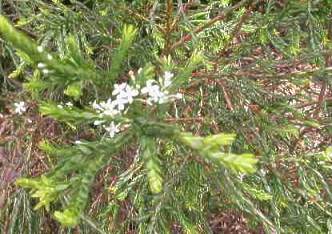Struthiola myrsinites
Struthiola myrsinites Lam.
Family: Thymelaeaceae
Common names: Juffertjie-roer-by-die-nag (Afr.)
Introduction
This is a delightful, slender shrub from the Cape flora, whose pale flowers scent the evening air. It is a member of the thyme family which is recognised by bark which tears into long strips.

Description
Description
Struthiola myrsinites is an open, willowy shrub which grows to a height of 2 m. The branches are tetragonal. It grows in both full sun and light shade, and can be found in bloom at any time of the year. The white or rarely pale pink flowers have a long, very narrow tube, topped with 8 finger-like petals. They are sweetly scented during the evening and attract moths as pollinators. It is this characteristic which gives rise to its common name which translates as 'little-lady-gad-about-at night.' A small sprig of flowers will perfume an entire room in the evening. The leaves are opposite, narrowly elliptic and acute.
The flowers have a well-developed calyx with 4 or 5 lobes, often resembling petals. The petals are absent or reduced to scale-like or fleshy lobes at the mouth of the calyx.
Distribution and habitat
Distribution description
Struthiola myrsinites occurs widely in sandy soil, often near watercourses. It grows from the Gifberg to Eastern Cape. There are about 42 species of Struthiola altogether, found in tropical and southern Africa, with about 20 of these occurring in the Cape Flora.
Derivation of name and historical aspects
History
The name Struthiola is derived from the Greek word for a small bird or sparrow and may refer to the tiny seed resembling a sparrow's beak. The specific name myrsinites refers to its similarity to the genus Myrsine, which name in turn refers to the Greek name for the common myrtle.
Growing Struthiola myrsinites
Grow
Seed is difficult to collect as it is so tiny. However, the plant strikes easily from tip cuttings taken from non-flowering branches. These are dipped in a rooting hormone and placed in a well-drained, sandy medium which is kept damp. Rooted cuttings are potted into larger bags before being planted in the garden. They may be planted in preferably semi-shaded or sunny areas. This is an ideal plant for a garden which is mostly enjoyed at night.
References
- BURMAN, L. & BEAN, A. 1985. Hottentots Holland to Hermanus. South African Wild Flower Guide 5. Botanical Society of South Africa, Cape Town.
- GOLDBLATT, P. & MANNING, J. 2000. Cape plants. A conspectus of the Cape flora of South Africa. Strelitzia 9. National Botanical Institute and Missouri Botanical Garden.
- BOND, P. & GOLDBLATT, P. 1984. Plants of the Cape Flora. A descriptive catalogue. Suppl. vol. No.13. Trustees of the National Botanical Institute, Cape Town.
- KESTING, D. 2001. Wild flowers of the Cape Peninsula: Botanical names : Origin and Meaning. Flora Documentation Project, Friends of the Silvermine Natura Area.
Credits
Berenice Carolus
Harold Porter National Botanical Garden
November 2002
Plant Attributes:
Plant Type: Shrub
SA Distribution: Eastern Cape, Western Cape
Soil type: Sandy
Flowering season: Sporadic/All year
PH: Acid
Flower colour: White
Aspect: Morning Sun (Semi Shade)
Gardening skill: Average
Special Features:
Horticultural zones









Rate this article
Article well written and informative
Rate this plant
Is this an interesting plant?
Login to add your Comment
Back to topNot registered yet? Click here to register.